UELI
STECK
WITH KARIN STEINBACH
TRANSLATED BY BILLI BIERLING
AFTERWORD BY STEVE HOUSE
UELI
STECK
MY LIFE IN CLIMBING
A LEGENDS AND LORE TITLE
MOUNTAINEERS BOOKS is the publishing division of The Mountaineers, an organization founded in 1906 and dedicated to the exploration, preservation, and enjoyment of outdoor and wilderness areas.
1001 SW Klickitat Way, Suite 201 Seattle, WA 98134
800.553.4453 www.mountaineersbooks.org
Originally published as Der nchste Schritt
2016 by Piper Verlag GmbH, Mnchen/Berlin, published under the imprint Malik
Translation copyright 2018 by Billi Bierling
Afterword copyright 2018 by Steve House
All rights reserved. No part of this book may be reproduced or utilized in any form, or by any electronic, mechanical, or other means, without the prior written permission of the publisher.
Printed in the United States of America
Distributed in the United Kingdom by Cordee, www.cordee.co.uk
21 20 19 181 2 3 4 5
Copyeditor: Chris Dodge
Design and layout: Heidi Smets
Cover photograph: Ueli Steck (Photo by PatitucciPhoto)
Library of Congress Cataloging-in-Publication Data
Names: Steck, Ueli, author. | Steinbach, Karin, author. | Bierling, Billi, translator.
Title: Ueli Steck : my life in climbing / by Ueli Steck, with Karin Steinbach; translated by Billi Bierling.
Description: Seattle, Washington: Mountaineers Books, [2018] | Series: Legends and Lore Series | Originally published as Der nachste Schritt
2016 by Piper Verlag GmbH, Munchen/Berlin, published under the imprint Malik -- T.p. verso.
Identifiers: LCCN 2017040143| ISBN 9781680511321 (pbk) | ISBN 9781680511338 (ebook)
Subjects: LCSH: Steck, Ueli. | Mountaineers--Switzerland--Biography.
Classification: LCC GV199.92.S73 S74 2018 | DDC 796.522092 [B] --dc23
LC record available at https://lccn.loc.gov/2017040143
Mountaineers Books titles may be purchased for corporate, educational, or other promotional sales, and our authors are available for a wide range of events. For information on special discounts or booking an author, contact our customer service at 800-553-4453 or .
 Printed on recycled paper
Printed on recycled paper
ISBN (paperback): 978-1-68051-132-1
ISBN (ebook): 978-1-68051-133-8
CONTENTS
EVEREST
WHEN THE WORLD SUDDENLY CHANGES
The highest mountain in the world is immensely attractive to a lot of people, and so it was for me. When I started to discover the challenges of high-altitude mountaineering at the beginning of the new millennium, I was unable to escape its fascination. During my first Everest attempt, from the north side in Tibet in 2011, I made it to about 100 meters below the summit. But when I stopped feeling my toes, I immediately turned back since I did not want to risk getting frostbite. A year later I reached the summit with my Nepali climbing partner Tenji via the normal route, on the south side, in Nepal. Despite the fact that I had climbed without supplemental oxygen, some people wondered what on earth I was doing on a heavily trodden path on an overcrowded mountain.
The answer was easy: Mount Everest offers a range of attractive routes and possible projects, but before I could even think about doing a technically challenging ascent, I needed to find out what to expect up there and how strong my body would be at an elevation of 8848 meters. The 2012 ascent went smoothly, and I acclimatized very well. This encouraged me to plan a more challenging route for the following season. It did not have to be the Horseshoethe traverse from Nuptse via Lhotse to Everest that had long been an unsolved climbing challenge. I hatched a more modest plan for spring 2013: an EverestLhotse traverse with my British friend Jonathan Griffith, who had lived in Chamonix in the French Alps for many years, and Italian climber Simone Moro, who is best known for his winter ascents of 8000-meter peaks.
Jon and I flew to the Nepalese capital, Kathmandu, at the end of March with Peter Fanconi and his friend Juan. The pair was going to accompany us to Everest Base Camp and then trek back on their own. Simone had already been in Nepal working as a helicopter pilot, and we had made arrangements to meet en route. As is frequently the case, we had to wait at the Kathmandu airport for our flight to Lukla. Small planes usually depart from Kathmandu only in the early morning, and if fog or clouds impair visibility, then all flights are canceled. As soon as the weather is good enough for the planes to fly, mayhem usually breaks out.
In Lukla, at 2860 meters, Twin Otter planes land in quick succession at an airstrip that is just 527 meters long. Immediately after touchdown, which is usually a bit rough, the pilots have to hit the brakes hard to avoid crashing into the wall, which seems to rapidly move closer. At the front of the airstrip, a cliff drops about 600 meters down toward the Dudh Khosi River. Once the airplanes have landed, its pandemonium. People want to retrieve their bags as quickly as possible because mix-ups can happen: Porters have been known to walk off with the wrong luggage.
As I had been to Nepal a few times before, I was not really fazed and was looking forward to trekking through the Khumbu. Since my first visit in 2001, I have always enjoyed coming back here. The region has somehow touched my heart. One can wander from lodge to lodge and enjoy the stunning views of snow-covered peaks rising up from the barren valley. The trails are very well maintained since thousands of people visit this beautiful region every year. We had picked a pretty quiet time. The main trekking season is traditionally fall, when thousands of visitors stomp through the valley, but tourism dropped after the devastating earthquake in the spring of 2015.
The first trekking stage took us from Lukla to Namche Bazaar, which, at 3440 meters, is considered the gateway to the real Himalaya. From here the peaks soar high into the sky. Since Base Camp lies 1600 meters higher, to avoid altitude-related headaches we took our time and had a rest day in Pangboche. In the morning we visited the local monastery and joined a Buddhist ceremony. Appeasement of the godspujais an important part of every expedition. Jon wasnt feeling well after the food he had eaten the previous day, but he was good-humored even though he had spent much of the night on the toilet. This is part of traveling in the Himalaya.
After our visit to the monastery, we continued to Dingboche (4500 meters), where we intended to stay for a couple of nights. Farther up the valley, one trail continues toward Mount Everest and the other one veers off to the Chukung Valley, which is closed in by the 5845-meter Amphu Laptsa Pass leading to the Makalu Valley. Instead of resting I made the most of my day by going for a run up the valley all the way to Chukung, from which I dashed up Chukung Ri, a 5546-meter summit.
After this beautiful start to our expedition, we trekked from Dingboche north to Lobuche, where we met Simone the following day. Now the team was complete, and slowly but surely we trekked to Base Camp, finally reaching it on April 11. Calling it a camp is something of an understatement, as it has become practically a city nestled in the mountains at 5300 meters. Every year various operators set up their tents on the moraine of the glacier, and yaks and porters carry tons of gear up the valley. During the climbing season around 1500 climbers, Sherpas, and expedition staff members call this their temporary home.

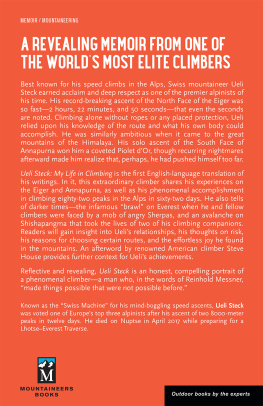
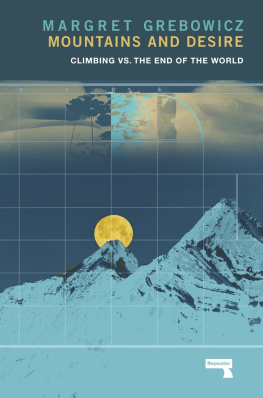
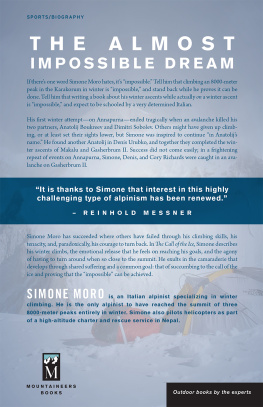


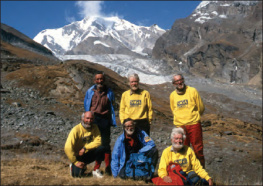
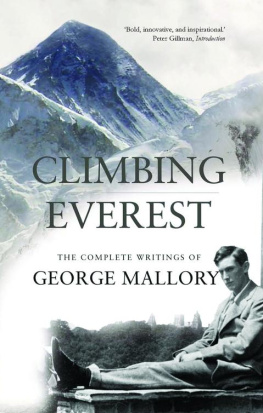

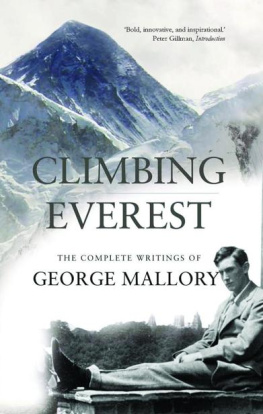




 Printed on recycled paper
Printed on recycled paper